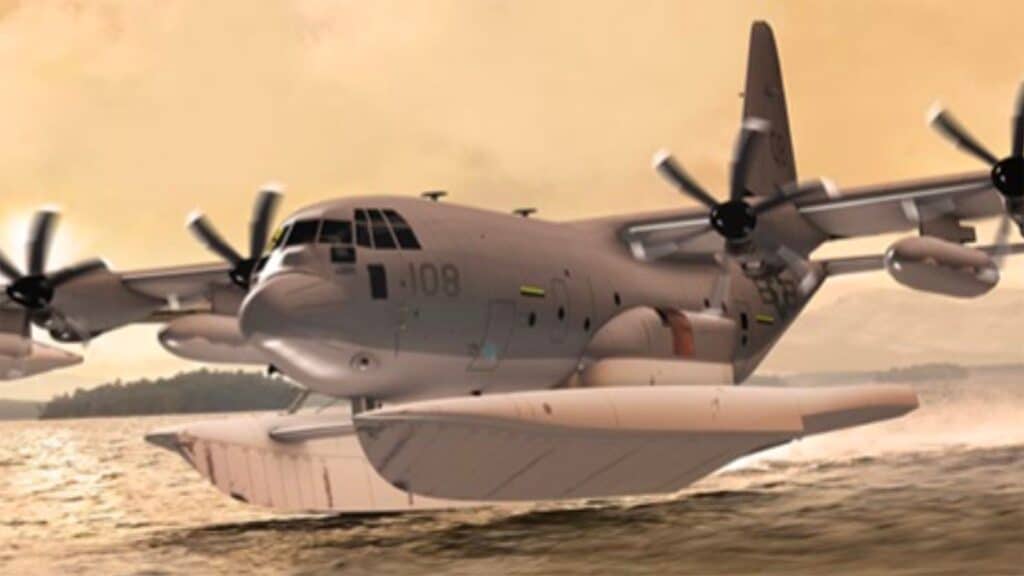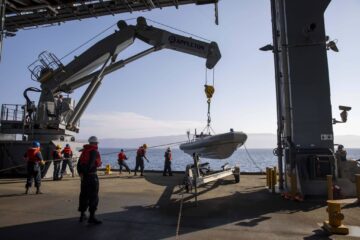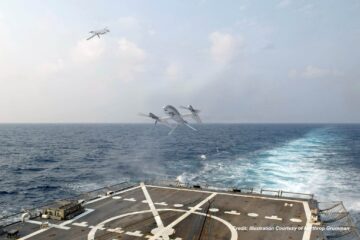In an unsettling time of disinformation and misinformation, tracking down the status of the “Hot Topic” amphibious MC-130J seaplane concept may be a futile effort in a time of peer nation challenges, heightened National Security, and Information Security.
After all, “Black Programs” abound within the Special Operations community, although the MC-130J itself isn’t considered a “Black Program,” but the U.S. Air Force’s next-generation B-21 “Raider” replacement stealth bomber is indeed a Top Secret classified program currently outside of the public eye and is considered a “Black Program” that has not seen the “light” of the Media.
The MC-130J belongs to the U.S. Air Force Special Operations Command (AFSOC), and being U.S. Air Force, they have their share of Secret “Black Programs.” The Next Generation Air Dominance (NGAD) fighter is another “Black Program,” also not seen in the Media or the public eye yet as it undergoes development.

Thus, one can only speculate as to the size, shape, performance, cost, armament, and capabilities of the B-21 and the NGAD. However, the MC-130J isn’t considered a secret, and to make it float technically shouldn’t be secret since the U.S. has operated seaplanes before during World War II such as the Consolidated PBY Catalina. Stories have been published as to the breaking news about the desire for a U.S. Special Operations floating MC-130J seaplane.
Naval News asked around the services for a status update in mid-2022, about one year since SOFIC 2021, and honestly given the nature of the times, the U.S. Department of Defense may choose not to reply and just ignore my inquires. However, some inquired branches did indeed reply to Naval News’ inquiries.

Naval News first asked Lockheed Martin, builder of the C-130J. Lockheed replied with the advice to ask the United States Special Operations Command (USSOCOM).
Naval News then asked USSOCOM. USSOCOM is the “guiding parent” headquarters of AFSOC and the other Special Operations service branches (the U.S. Army, U.S. Marines, and the U.S. Navy), and according to Lt. Cassandra Thompson, she has asked around USSOCOM.
“There is no requirement for an amphibious C-130. It’s not a Program of Record.”
Lt. Cassandra Thompson, Media & Plans Officer, USSOCOM
Naval News also inquired to the U.S. Navy’s Naval Air System Command (NAVAIR) via the U.S. Navy’s Chief Information Office (CHINFO) because if an amphibious C-130, even if classified a “Black Program Secret,” were to land on water, surely someday it would have to “float and swim” towards a dock, pier, beach, or port under U.S. Navy control and guarded by U.S. Marines that will actually see it and report it. CHINFO’s NAVAIR representative replied.
“I can’t find an owner of the C-130 [amphibious] concept, so I don’t think it’s moved past the comments you found.”
Susan Guth, Public Affairs Specialist, CHINFO News Desk, Navy Office of Information
Granted, the MC-130J seaplane concept belongs to AFSOC. Naval News inquired to AFSOC in May 2022 and did not receive an immediate reply.
Author’s Comments

For speculative discussion purposes, the idea for a U.S. floating seaplane seems tantalizingly appealing as such a concept, if fulfilled, would bring cargo, logistics, unmanned vehicles, Special Operations swimmers and divers, jetskis and inflatable boats, and other new ideas that can fit inside the C-130’s cargo hold right onto the surface of the water as the amphibious (M)C-130 lands.
Having a seaplane increases logistical, tactical, and strategic mobility as any seaplane will not be constricted to landing on paved or austere runways, and given the vastness of the world’s oceans, and the Earth being covered seventy-one percent by water, the MC-130 seaplane concept seems to realistically gain buoyancy. If built and fielded, every armed service branch seems to want one, and with air-to-air refueling capabilities, the MC-130J seaplane just seems like a logical choice to fund and make.

Ostensibly, in all fairness, the cargo and special Operators that USSOCOM MC-130J seaplanes would carry, if the amphibious MC-130J seaplane is actually built, may indeed be considered classified “Secret” compared to cargo that the U.S. Marines, Navy, or Coast Guard would carry. It’s called “Plausible deniability” and is a tactic that is used to neither confirm nor deny the existence of acquisitions and programs that may affect current and future National Security and inventory and arsenal secrecy.
If USSOCOM and NAVAIR are indeed practicing “Plausible deniability” is anyone’s guess outside of the circles of the (M)C-130J seaplane concept, or perhaps the (M)C-130J seaplane concept just isn’t mature enough to report anything at the moment.
Bring Forth the DARPA “Liberty Lifter!”

While the USSOCOM MC-130J seaplane concept may appear in limbo as of mid-2022 because no one in the U.S. Defense Department knows or is willing to admit its status, the U.S. Defense Advanced Research Projects Agency (DARPA) is, respectably, forging ahead on its concept that Naval News covered in August 2021. The concept is to design a “Wing in Ground Effect seaplane” and you can read about it here.
In fact, a search for “Seaplane” under the U.S. federal government contracts public records actually produces just one result, and that is DARPA’s “Liberty Lifter.”
The DARPA April 25, 2022 “Liberty Lifter” requirement (Notice ID: HR001122S0027) calls for:
Description: The Liberty Lifter program will design, build, and flight test an affordable, innovative, and disruptive seaplane that operates efficiently in ground effect, can sustain out of ground effect flight, and enables efficient theater-range transport of large payloads at speeds far exceeding existing sea lift platforms.
Sea States Environment:
1) Safe, long-endurance operations in high sea states
a. Takeoff and land in sea states up to 4
b. Fly-in ground effect in sea states up to 5
c. On-water operations in sea states up to 5
d. Persistent on-water float for up to 4-6 weeks at a time.
2) Sustained unpressurized flight out of ground effect to enable avoidance of bad weather and
obstacles, flight over some landmasses, and operational flexibility.

Cargo capacity: At least: 2 x USMC Amphibious Combat Vehicle (ACV) or 6 x Twenty Foot Equivalent Container Units (TEUs)
Performance: The aircraft is expected to have an operational range of at least 4,000 nmi (4,603 miles/7,407 kilometers) per sortie, after which it may be refueled. The vehicle design is expected to allow any cleaning, inspection or maintenance activities occurring more regularly than 4-6 weeks to be completed while the vehicle is afloat.
“Question: Which agencies will oversee X-Plane airworthiness and seaworthiness?
Answer: DARPA.”
DARPA Broad Agency Announcement “LIBERTY LIFTER TACTICAL TECHNOLOGY OFFICE”
The U.S. Marine Corps’ Amphibious Combat Vehicle has a gross weight of 67,500 pounds (30,617 kilograms) or 33.75 tons, and the “Liberty Lifter” is required to carry two of them or around 67.5 tons. This carrying weight is smaller than the initial DARPA WIG cargo plane rating of 100+ tons. Two ACVs is about the cargo-carrying weight of a C-17 at 72.6 tons (160,000 pounds).
With the DARPA’s WIG’s official Program of Record, maybe the USSOCOM MC-130J seaplane concept is alive and well somewhere out there…just a seed or a sapling waiting to grow larger and taller. One thing is certain…DARPA moves ahead on the Program of (public) Record.
Stay tuned to Naval News for more updates on the quest for United States seaplanes.
Update:
DARPA released some new details about its Liberty Lifter program on 18 May 2022:






